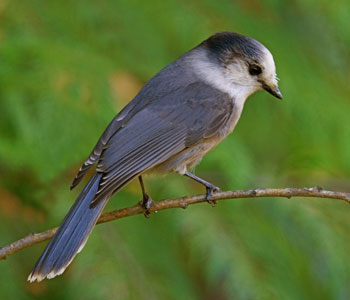
NatureMapping Animal Facts for Kids
Gray Jay
|
Gray Jay (Perisoreus canadensis)
Juveniles are entirely sooty black with white moustache mark. The pale bill of the young eventually turns dark like the adult. The coloration of the juveniles helps them to blend in with the forests.
Calls:
Calls soft and harsh, "cha-cha-cha-cah." Also clear whistled "whee-oo." Where they live: During the summer they live in boreal forest from Alaska to Newfoundland, southward to northern New Hampshire, northern New York, and Minnesota. They also are found southward in the western mountains to Arizona and New Mexico. Gray Jays are found primarily in mature, humid, sub-alpine, spruce forests. They do not generally breed below 2,000 feet, and are most often found from 3,000 feet and above to the tree line, although some are found nesting locally in lowland habitats. In Washington, the Gray Jay is common in moderate and high elevation conifer forests throughout the state and locally at lower elevations in western Washington in coastal rain forests of the Olympic Peninsula, Willapa Hills, and the Fort Lewis area (Pierce/Thurston Counties). Gray Jays require mid-to late-seral coniferous forests. Click the range map to learn more about the distribution of Gray Jays in Washington. 
What they eat: Grey Jays are omnivorous, meaning that they eat plants and animals. They feed on fungi, small rodents, eggs, fruit, berries, and insects. They are attracted to campsites where they steal as much food as possible. They are known by many people as Camp Robbers. Behavior: Gray Jays are often found in family groups. They can be very bold and will beg from campers, follow hikers, and go inside cabins to steal food. These jays forage from perches and fly from tree to tree, scanning for food. They cache food during the summer and fall, using sticky saliva to paste it in between bark and other hidden spots above the height of the eventual snow line. The Gray Jays eat this stored food during the winter when other food sources are scarce. It may be this food storage behavior that allows the Gray Jay to survive, far north, throughout the winter. Gray Jays often carry food with their feet in flight, which is unusual for songbirds. Other songbirds carry food in their beaks - like the American Robin. (sources: Birdweb; All About Birds)
Did you know?

Gray Jay More information:
|

